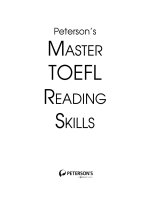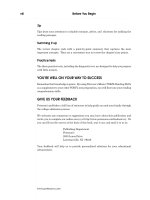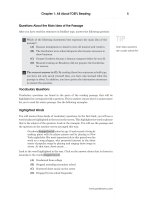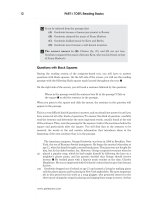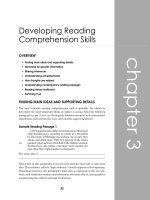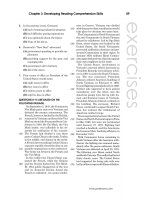Peterson’s master toefl writing skills part 15 ppt
Bạn đang xem bản rút gọn của tài liệu. Xem và tải ngay bản đầy đủ của tài liệu tại đây (67.45 KB, 7 trang )
5. They are said ________ a dynamic
new play.
(A) to have wrote
(B) to have written
(C) to have writing
(D) have written
6. Last year in the middle of the most
severe drought in recent history, the
already dwindling tribe ________
finally to leave its ancestral land
and to look for a new place to live.
(A) had decided
(B) decided
(C) has decided
(D) decides
7. It was important that they ________
before the curtain went up last
night.
(A) arrive
(B) have arrived
(C) arrived
(D) had arrived
8. I could see Susan’s hands ________
slightly as she placed her papers on
the podium and prepared to address
the audience.
(A) to tremble
(B) trembles
(C) trembled
(D) trembling
9. The babysitter agreed ________ the
children before putting them to bed.
(A) for bathing
(B) to bath
(C) to bathe
(D) to giving a bath
10. When the famous pianist was a
child, he was accustomed to ________
for several hours a day.
(A) practice
(B) practicing
(C) practiced
(D) be practicing
exercises
Chapter 4: Verbs 87
www.petersons.com
ANSWER KEY AND EXPLANATIONS
Part A
C
1.
X
2. (could have eaten). See Past
Participles, page 81.
X
3. (opposed to using). See
Verbals, page 77.
C
4.
X
5. (has been attempting). See
Tense, page 67.
X
6. (If I get). See Conditionals,
page 73.
C
7.
X
8. (he found). See Tense, page
67.
X
9. (Having read). See Present
and Perfect Participles and
Infinitives, page 84.
X
10. (that he had gone). See
Wishes, page 71.
Part B
1. C
2. A
3. D
4. D
5. B
6. B
7. A
8. D
9. C
10. B
1. The correct answer is (C). Choices
(A), (B), and (D), see Modals, page 75.
2. The correct answer is (A). Choices
(B), (C), and (D), see Verbals, page 77.
3. The correct answer is (D). Choices
(A), (B), and (C), see Conditionals,
page 73.
4. The correct answer is (D). Choices
(A), (B), and (C), see Tense, page 67.
5. The correct answer is (B). Choices
(A), (C), (D), see Present and Perfect
Participles and Infinitives, page 84.
6. The correct answer is (B). Choices
(A), (C), and (D), see Tense, page 67.
7. The correct answer is (A). Choices
(B), (C), and (D), see Verbs of “De-
mand,” page 70.
8. The correct answer is (D). Choices
(A), (B), and (C), see Verbals, page 77.
9. The correct answer is (C). Choices
(A), (B), and (D), see Verbals, page 77.
10. The correct answer is (B). Choices
(A), (C), and (D), see Verbals, page 77.
88 PART III: TOEFL Writing Review
www.petersons.com
SUMMING IT UP
• Common verb-tense problems are related to the present perfect, past tense and past
perfect. It is possible to use the past perfect in sentences where before or after show
sequence, but it is not necessary.
• There are two kinds of conditions—real and unreal. Real conditions are used for possible
situations. Unreal conditions are used for impossible or unreal situations.
• After all modals, use the simple form of the verb.
Chapter 4: Verbs 89
www.petersons.com
Pronouns
OVERVIEW
• Relative pronouns
• Personal pronouns—case
• Who/whom
• Possessives
• Faulty reference
• Person
• Number
• Those modified
• Summing it up
RELATIVE PRONOUNS
Who, whom, which, that, and whose are relative pronouns used to introduce
relative clauses (adjective clauses). For the who/whom problem, see page 95.
1. Who and whom are used for people.
I saw the man who is famous for inventing plastic.
Give it to the man whom you already know.
2. Which is used for nonrestrictive, or nonessential, clauses; that is,
clauses that are not essential to the meaning of the sentence. Note that
nonessential clauses are always preceded and followed by a comma.
The 104 bus, which is always late, should arrive at 4 p.m. at the
shopping center.
3. That is used for restrictive, or essential clauses. You do not use a
comma with essential clauses.
Here is the man that can answer your questions.
Did you find the book that you wanted to buy?
chapter 5
91
4. Whose is used to show possession. It can be followed by persons or things.
This is the man whose car was towed away.
Do you know the doctor whose children I teach?
Error Examples
WRONG: He is the student which always arrives late.
RIGHT: He is the student who always arrives late.
OR
He is the student that always arrives late.
WRONG: Saudi Arabia is a country who exports oil all over the world.
RIGHT: Saudi Arabia is a country that exports oil all over the world.
WRONG: We visited the building what is famous for its unusual design.
RIGHT: We visited the building, which is famous for its unusual design.
OR
We visited the building that is famous for its unusual design.
WRONG: There was a story in the paper about the man that his car was stolen.
RIGHT: There was a story in the paper about the man whose car was stolen.
Skill Builder 1: Relative Pronouns
Directions: Write a “C” on the line if the sentence is correct. Write an “X” on the line if
there is an error in the relative pronoun.
1. I like novels who deal with philosophical questions.
2. The company did not want to hire a man that his experience was so limited.
3. The family whose house burned down was on television.
4. She wore a dress what everyone considered extravagant.
5. The train, which goes to Flower Square, will arrive at any moment.
6. The ship that we boarded in Rio was bound for Marseilles.
7. John did not want to do business with a man which had been in prison.
8. Take your car back to the man who sold it to you.
9. That is the baby which has been in the incubator for three months.
10. The woman that her photograph was in the paper is making a speech at the
town hall tonight.
92 PART III: TOEFL Writing Review
www.petersons.com
Answers
X
1. (novels that deal). See rule 3.
X
2. (a man whose experience).
See rule 4.
C
3.
X
4. a dress that). See rule 3.
C
5.
C
6.
X
7. (a man who)OR(amanthat).
See rules 1 and 3.
C
8.
X
9. (the baby who) OR (the baby
that). See rules 1 and 3.
X
10. (woman whose photograph).
See rule 4.
PERSONAL PRONOUNS—CASE
1. Subject pronouns (I, you, he, she, it, we, and they) are used in the subject position and
after the verb to be.
They
S
arrived safely last night.
It was they
BE 1 S PRON.
who knocked on the door last night.
2. Object pronouns (me, you, him, her, it, us, and them) are used as objects of verbs and
prepositions and as subjects of infinitives.
I told
VERB
him
OBJ.
the news.
Between
PREP.
you and me
OBJ.
, the economic situation looks bad.
We asked him
S
to bring
INFIN.
a salad to the party.
a. Pronouns in apposition* are in the same case as the pronouns they follow.
Example: Let’s (Let us), you and me, go dancing Friday night. Us is the
object of let. Yo u and me must also be in the objective case.
b. Pronouns after the conjunctions as or than should be subject pronouns
when they function as subjects.
He is as tall as I
S
(am tall).
John plays soccer as well as he
S
(plays soccer).
They are more diligent students than we
S
(are).
c. The correct forms of the reflexive pronouns for him and them are himself
and themselves, NOT hisself or theirselves.
*Anappositive is a noun or pronoun that follows another noun or pronoun and identifies
the first noun or pronoun.
Chapter 5: Pronouns 93
www.petersons.com

